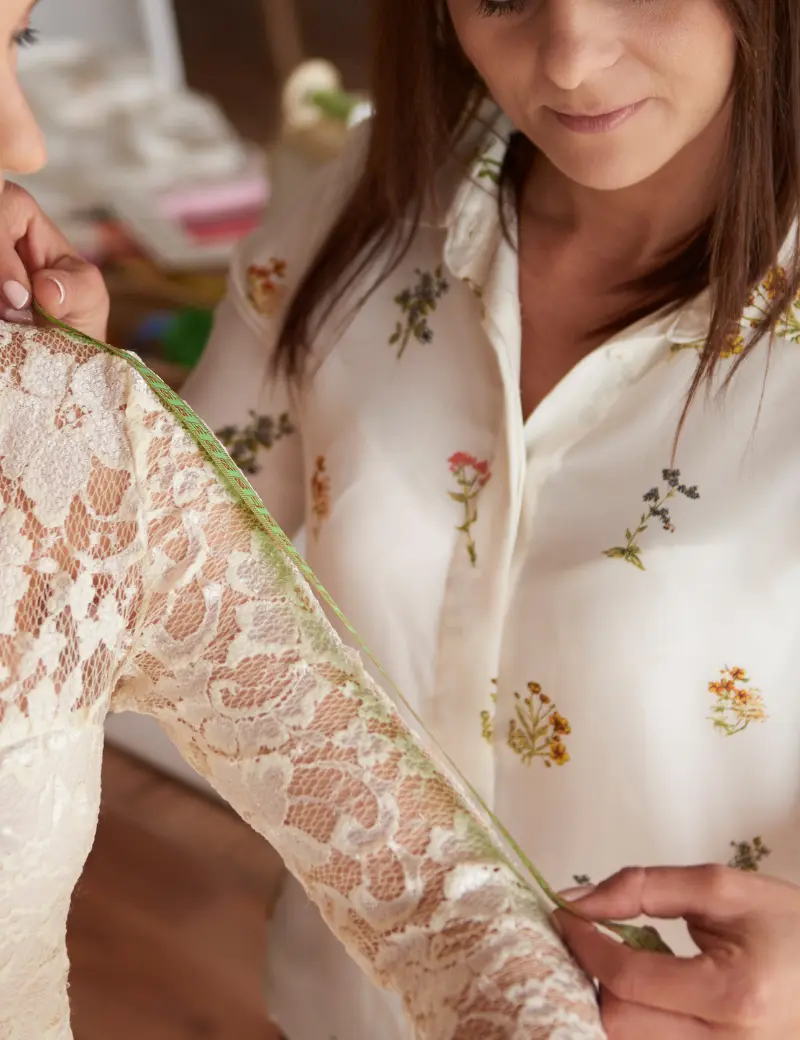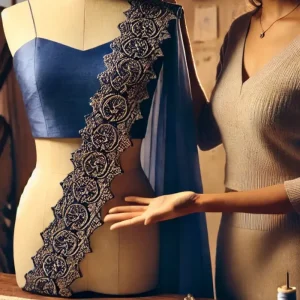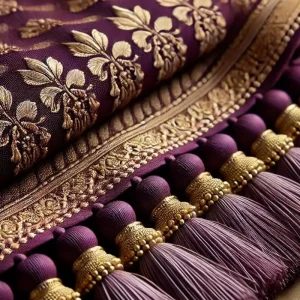No products in the cart.
Sleeve Adjustment Services for Women’s Clothes
From ₹149.00
Enhance the fit and style of your Indian attire with our Sleeve Adjustment Service. Whether you’re looking to adjust the sleeves of a saree blouse, kurti, Anarkali, lehenga choli, or fusion wear, our expert tailoring ensures a flawless, comfortable fit that complements your unique body shape and personal style.
Description
Adjusting the sleeves on Indian women’s garments can make a big difference in both comfort and style. Whether you’re working with a saree blouse, kurti, lehenga choli, Anarkali, or any other Indian outfit, the right sleeve adjustment ensures a polished and flattering fit. Here are a few pointers on how to adjust sleeves on Indian garments:
1. Adjusting Sleeves for Saree Blouses:
- Fit Around the Arm: If the sleeves of your saree blouse are too tight around the arm, you can let out the side seam slightly, adding a bit of extra room. This is especially helpful for comfort if the blouse has a fitted sleeve style. Conversely, if the sleeve feels too loose, you can take in the side seam to make it more fitted and snug.
- Sleeve Length: The length of the sleeve on a blouse can vary from short sleeves, three-quarter sleeves, to full-length sleeves. If the sleeve is too short or too long, it can be easily adjusted by taking in or letting out the length of the fabric. For full-length sleeves, ensure that the sleeve hits just below the wrist for a balanced, elegant look.
- Adjusting Sleeve Opening (Cuffs): If the opening of the sleeve is too wide or too tight, it can be adjusted for a more comfortable fit. You can adjust the cuff by taking in the fabric or letting it out, depending on the desired fit. For a more fitted look, you can add a button or hook-and-eye closure to the cuff to control how tight or loose it feels.
2. Sleeve Adjustments for Kurtis and Tunics:
- Shortening or Lengthening Sleeves: Kurtis and tunics often come with a variety of sleeve lengths—cap sleeves, elbow-length, three-quarter sleeves, and long sleeves. If the sleeve length doesn’t suit you, shortening or lengthening them is a simple adjustment. To shorten, you can trim the sleeve and fold the edge neatly. To lengthen, you can add extra fabric from the hem (if seam allowance permits).
- Fitting the Sleeves: If the sleeves are too loose or too tight, take in or let out the side seams to make the fit more flattering. For tighter sleeves, ensure that the armhole itself isn’t too tight, as this can cause discomfort. If the fit is too loose, taking in the side seams around the elbow and upper arm can provide a more streamlined look.
- Sleeve Opening Adjustments: If the sleeve opening feels too tight (especially for long sleeves or three-quarter sleeves), you can make it wider for a comfortable fit, or alternatively, taper the opening for a more structured look. Adding a slit or cut-out design at the sleeve opening can also provide a modern, stylish touch.
3. Adjusting Sleeves for Anarkalis and Lehenga Cholis:
- Fitted Sleeves: For a fitted sleeve on an Anarkali or lehenga choli, you can adjust the side seam and underarm seam for a more snug fit. Make sure that the sleeve is comfortable and doesn’t restrict movement, especially around the upper arm and elbow.
- Puff or Bell Sleeves: If the sleeves are too puffy or bell-shaped and you want a more defined look, you can reduce the volume by tapering the sleeve or removing excess fabric. Conversely, if you want to add more volume or flair, additional pleats or fabric can be added to the sleeve for a fuller effect.
- Cuff or Zipper Adjustments: Some lehenga cholis and Anarkalis have cuffed sleeves or zipper sleeves. If the cuff is too tight, it can be loosened by letting out the seam or adding an extra button for a more adjustable fit. If a zipper sleeve feels uncomfortable, you can change the length or loosen the zipper for added comfort.
4. Adjusting Sleeves for Fusion Wear (Indo-Western Dresses):
- Cap Sleeves & Spaghetti Straps: For fusion wear, such as Indo-Western dresses, you can adjust cap sleeves or spaghetti straps to suit your preferences. If the straps are too long or short, they can be altered for a more balanced and comfortable fit.
- Off-Shoulder or Cold-Shoulder Sleeves: For modern fusion wear with off-shoulder or cold-shoulder designs, you can adjust the fit around the shoulder area for more comfort or style. If the off-shoulder cut feels too tight or loose, it can be taken in or let out along the neckline or shoulder seams to ensure a perfect fit.
- Sleeve Detailing (Ruffles, Frills, & Layers): If the sleeve features additional details like ruffles, frills, or layered fabric, you can adjust the amount of fabric used to create a more subtle or dramatic effect. Adding or removing layers from the sleeve can change the overall silhouette and style of the garment.
5. Sleeve Adjustments for Long-Sleeve Kurtas and Dresses:
- Armhole Adjustments: For long-sleeve kurtas or dresses, it’s important to make sure the armhole isn’t too tight. A tight armhole can restrict movement and be uncomfortable, so it’s important to adjust it to fit the natural curve of the arm without being restrictive. If needed, take in or let out the armhole for a more comfortable fit.
- Adding or Removing Pleats: Long sleeves on kurtas or dresses often feature pleats at the cuff or elbow for added style. If you want to adjust the look or fit, you can add or reduce the number of pleats to make the sleeve looser or more fitted. You can also adjust the pleats’ depth for more volume or structure.
- Elasticated Sleeves: Some modern Indian designs feature elasticated sleeves at the wrist or elbow. If the elastic feels too tight, you can replace it with a more comfortable band or loosen the elastic for a relaxed fit. If the sleeve is too loose, you can add a tighter band or elastic to achieve a more fitted look.
6. General Sleeve Adjustment Tips:
- Seam Allowance: Always check the seam allowance of the sleeve when making adjustments. Many garments leave extra fabric for alterations, especially along the armhole or sleeve length. Use this fabric to make the necessary adjustments without compromising the overall fit and design of the garment.
- Comfort & Flexibility: Ensure that any sleeve adjustment allows for movement and doesn’t feel restrictive. Sleeves should fit comfortably around the shoulder, upper arm, and wrist without causing discomfort, especially for long wear.
- Balance with the Garment’s Style: When adjusting sleeves, keep in mind the overall aesthetic of the garment. For example, if you’re altering a long, voluminous sleeve (like a bell sleeve or puff sleeve), ensure that the adjusted sleeve still complements the design of the garment and the rest of the outfit.
7. Adding Decorative Elements to Sleeves:
- Lace, Embroidery, or Trim: If you’re adjusting the sleeve to be more fitted, consider adding lace, embroidery, or decorative trim at the sleeve opening or hem for a custom, unique touch. These elements can elevate the style and add an extra layer of detail to the sleeve.
- Adding Cuffs or Loops: For a more traditional or formal look, you can add cuffs, buttons, or decorative loops to the sleeve for a more finished and stylish look. These additions can also help adjust the sleeve length, particularly for full-length sleeves.






